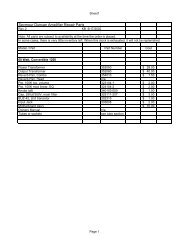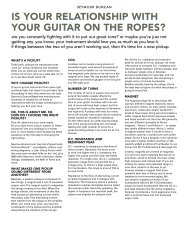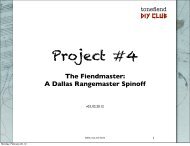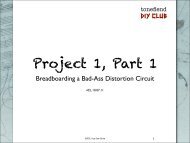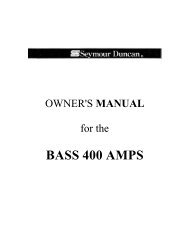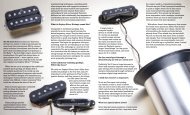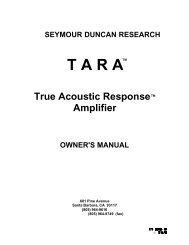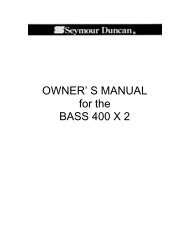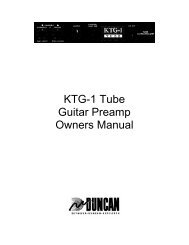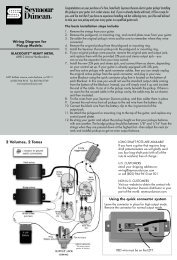84-40 TUBE AMPLIFIER OWNER'S MANUAL - Seymour Duncan
84-40 TUBE AMPLIFIER OWNER'S MANUAL - Seymour Duncan
84-40 TUBE AMPLIFIER OWNER'S MANUAL - Seymour Duncan
Create successful ePaper yourself
Turn your PDF publications into a flip-book with our unique Google optimized e-Paper software.
<strong>84</strong>-<strong>40</strong> <strong>TUBE</strong> <strong>AMPLIFIER</strong><br />
<strong>OWNER'S</strong> <strong>MANUAL</strong>
CAUTION<br />
To prevent electrical shock, do not operate this unit in wet or moist areas.<br />
There are no user serviceable parts inside. (See, "Maintenance" and "'Tube Chart" sections for<br />
user maintenance procedures.)
Congratulations on your purchase of the <strong>Seymour</strong> <strong>Duncan</strong> Research <strong>84</strong>-<strong>40</strong> Tube guitar amplifier.<br />
The <strong>84</strong>-<strong>40</strong> Tube is the product of art intense research and development effort. Our object was to<br />
provide guitarists with an affordable, all-tube amplifier, which sounded great.<br />
The <strong>84</strong>-<strong>40</strong> Tube is based on classic principles of tube guitar amplifier design. An all-tube preamp<br />
drives a quartet of EL-<strong>84</strong> power tubes, which provide the sweetest, most musical tone possible.<br />
The rectangular cabinet shape enhances the spacious "breathing" quality of the sound. Features<br />
such as on-board reverb and a buffered effects loop make the <strong>84</strong>-<strong>40</strong> Tube a simple, functional<br />
rig, which can adapt to any musical situation.<br />
Read this manual carefully to familiarize you with the features and operation of the <strong>84</strong>-<strong>40</strong> Tube.<br />
Your new amp will provide years of trouble free performance, great tone and musical fun.
TABLE OF CONTENTS<br />
Front Panel Diagram<br />
Performance Applications and Guidelines<br />
Rear Panel Diagram & Tube Chart<br />
Maintenance<br />
Trouble Shooting<br />
Warranty<br />
Notes
<strong>84</strong>-<strong>40</strong> <strong>TUBE</strong> AMP FRONT PANEL<br />
PERFORMANCE APPLICATIONS AND GUIDELINES<br />
The name of the <strong>84</strong>-<strong>40</strong> Tube amp reflects its design - the amp uses a quartet of EL-<strong>84</strong> type tubes<br />
to produce <strong>40</strong> watts of power.<br />
The EL-<strong>84</strong> tube was chosen specifically for its rich, sweet toile qualities, especially when pushed<br />
to distortion. This tube was widely used in many early amplifiers, but it is most famous for its use<br />
in the Vox AC-30. This was the amp used on the early Stones, Beatles and Yardbirds records.<br />
The EL-<strong>84</strong> has a wonderful musical character - it sings, it growls, and it has great dynamic<br />
response. The harder you play, the more it distorts and sustains. Back off on your attack and it<br />
"idles", cleaning up the sound. In short, EL-<strong>84</strong>'s are a ton of fun!<br />
The first thing you'll probably notice about your amp is that it's very loud for its size. We wanted to<br />
make an amp for the working guitarist- something that could cut it in most club and casual gig<br />
situations. The <strong>84</strong>-<strong>40</strong> Tube has more than enough kick to keep up with a loud drummer and bass<br />
player. In fact, when we were testing prototypes in clubs around town, the <strong>84</strong>-<strong>40</strong> Tube had no<br />
trouble holding its own on a stage full of 50 and 100-watt amps.<br />
Using the <strong>84</strong>-<strong>40</strong> Tube live is simple. Just use your ears to dial in the EQ settings you need,<br />
depending on the type of pickups in your guitar, the demands of the job, etc. Switch channels to<br />
find a balance between clean and overdrive settings. A typical lead/rhythm sound setting might<br />
be:<br />
EQ/TONE CONTROLS<br />
Even though both channels share the same tone controls, the <strong>84</strong>-<strong>40</strong> Tube amp has been<br />
carefully voiced for a smooth natural transition between channels. By switching back and forth a<br />
few times and adjusting the gain controls of each channel, it will be easy to get the proper tone<br />
and volume balance between clean and distortion sounds.
GAIN BOOSTS<br />
The <strong>84</strong>-<strong>40</strong> Tube has two gain boosts, which are activated, by push/pull pots on the overdrive<br />
control of each channel. Pulling out the overdrive control of Channel One actives a subtle 6 dB<br />
boost on both channels. Pulling out the OD control on Channel Two activates a stronger, 10 dB<br />
boosts on Channel Two only. In general, these boosts are designed to get more bottom end,<br />
punch and sustain when using the amplifier at low volumes. As the volume increases, the need<br />
for added low frequency response decreases. Using the boosts at high volume levels may<br />
produce unwanted "mushiness" in the sound.<br />
BRIGHT SWITCH<br />
The bright switch is activated by pulling out the master volume pot of Channel One. This adds<br />
6-12 dB of boost at 6 kHz for more "crispness" and shimmer to the high end of Channel One only.<br />
TONE TIP<br />
Your <strong>84</strong>-<strong>40</strong> Tube will get the richest, most dynamic tone when the power amp section is working<br />
hard; i.e. when the master volume control is up around 4 or 5. With the preamp volume around<br />
6-7 and the master at 4-5, the <strong>84</strong>-<strong>40</strong> Tube will produce a punchy "clean" distortion - plenty of<br />
sustain and harmonics, but without too much "fuzz" cluttering up the sound. For maximum<br />
overdrive and distortion, run the preamp volume at 10.<br />
REVERB<br />
Reverb adds a spacious quality to your tone. The reverb control affects both channels. Set for the<br />
amount of reverb you need. BE CAREFUL! Too much reverb may cause feedback. EFFECTS<br />
LOOP<br />
EFFECTS LOOP<br />
The effects loop allows you to place your effects into the signal path after the preamp, for<br />
smoother, quieter operation. To use the effects loop, run a cable from the "send" jack to the input<br />
of your effect device. Then come out of the effect to the "return" of the effect loop.<br />
To switch channels, use the front panel channel selector switch or use a remote footswitch. If you<br />
use a footswitch, you'll need a single pole/single throw on/off type switch. Do not use an FET<br />
momentary type.
<strong>84</strong>-<strong>40</strong> <strong>TUBE</strong> AMP REAR PANEL<br />
Primary fuse<br />
For I 1OOV & 120V operation, use a 2A/250V slo-blo<br />
For 220V & 2<strong>40</strong>V operation, use a 1A/250V slo-blo<br />
AC cord<br />
4-ohm speaker output<br />
8-ohm speaker output.<br />
<strong>TUBE</strong> CHART<br />
The <strong>84</strong>-<strong>40</strong> Tube uses:<br />
3 12AX7 (also known as ECC 83 or 7025) preamp tubes, and<br />
4 EL-<strong>84</strong> (also known as 6BQ5 or 7189) power tubes.
MAINTENANCE<br />
Most maintenance procedures for your amp will involve the tubes. Refer any other necessary<br />
work or adjustments to a qualified technician. THERE ARE NO USER SERVICEABLE PARTS<br />
INSIDE. If your amp requires service, contact the <strong>Seymour</strong> <strong>Duncan</strong> factory for the name of your<br />
nearest Authorized Service Center. PLEASE NOTE: WE CANNOT ACCEPT UNITS SHIPPED<br />
TO THE FACTORY WITHOUT A RETURN AUTHORIZATION NUMBER.<br />
The 12AX7 preamp tubes should last up to 2-3 years, depending on the amount of use.<br />
Symptoms, which indicate failing pre-amp tubes, include:<br />
-Any intermittent noise (sputtering, ringing, etc.) that seems to come and go as the amp warms<br />
up.<br />
-Excessive white noise or hiss.<br />
-Inability to get a clean sound, even a low volume levels.<br />
The EL-<strong>84</strong> tubes in the power section of the amp could last up to 2 years, depending on volume<br />
levels and hours of use. High volume playing 3-4 hours a day, 5-6 days a week could wear out a<br />
set of output tubes in a little as 6 months.<br />
Symptoms, which indicate worn power tubes, include:<br />
-Loss of power, punch; amp sounds "mushy" when pushed.<br />
-Excessive hum.<br />
If the outer plates of a tube begin to glow brightly, this tube has shorted. Turn off the amp and<br />
replace the tubes, preferably with a matched set. It's OK in an emergency to replace only one<br />
output tube, but all four output tubes should be replaced ASAP with a matched set. These are<br />
tubes, which have been tested and matched according to their power and performance<br />
characteristics (ex. RAM labs tubes, Groove Tubes, etc.). A matched set of power tubes will<br />
significantly lower audible hum and increase power output (possibly as much as 10-20 watts).<br />
This will offer more clarity on the clean channel and a tighter low-end response for a punchier<br />
overdrive sound. Also, when replacing the output tubes on your amp, it is good to have the amp's<br />
bias control adjusted to achieve the optimum performance from a set of tubes. ALWAYS REFER<br />
THE AMP TO A QUALIFIED TECHNICIAN FOR BIAS ADJUSTMENT.<br />
Always store your amp in a dry area. Storage in damp areas will cause corrosion of internal<br />
electrical contacts (switches, pots, jacks, etc.) and will in time degrade the performance of the<br />
amp. Amps used in damp environments should be periodically cleaned by a qualified technician.<br />
Symptoms, which may indicate corrosion, include:<br />
-Potentiometer rotational noise (volume or tone controls sound "scratchy" when turning). Use of a<br />
commercially available tuner spray will work in most cases.<br />
-Intermittent or noisy jacks.<br />
-Intermittent tube noise that is affected by slightly wiggling the tube in its socket.<br />
To maintain the tolex covering on your amp, use "armor-all" type cleaner.
PERSONAL SETTINGS<br />
Note your favorite <strong>84</strong>-<strong>40</strong> Tube Tones:
SEYMOUR DUNCAN LIMITED WARRANTY<br />
Please read carefully: <strong>Seymour</strong> <strong>Duncan</strong> amplifiers (hereinafter referred to is the Product) ire<br />
warranted against defects in workmanship and materials, excluding tubes covered separately, for<br />
a period of one year from date of purchase to the original purchaser. Tubes are warranted for 90<br />
days from date of purchase. This warranty is not transferable.<br />
Defective parts will be repaired or replaced without charge if the product is returned to the<br />
<strong>Seymour</strong> <strong>Duncan</strong> factory, at the address below or to a <strong>Seymour</strong> <strong>Duncan</strong> Authorized Service<br />
Center. In the event a product is to be returned to the <strong>Seymour</strong> <strong>Duncan</strong> Factory for repairs, A<br />
RETURN AUTHORIZATION MUST BE OBTAINED PRIOR TO SHIPPING BY CALLING OR<br />
WRITING THE COMPANY FOR THE RA NUMBER.<br />
When returning make certain to include copy of bill of sale. Any product shipped must be returned<br />
in the ORIGINAL SHIPPING CONTAINER WITH ORIGINAL PACKING MATERIAL and freight<br />
prepaid. Transportation charges involved in warranty service are the sole responsibility of the<br />
purchaser.<br />
This warranty does not apply to damage caused by misuse, mishandling, negligence in use or<br />
maintenance or storage, and is voided if repairs or adjustments are made after purchase by<br />
anyone other than the <strong>Seymour</strong> <strong>Duncan</strong> factory or a <strong>Seymour</strong> <strong>Duncan</strong> Authorized Service<br />
Center. <strong>Seymour</strong> <strong>Duncan</strong> reserves the right to be the sole judge as to the misuse or abuse of the<br />
product.<br />
The company assumes no liability for incidental or consequential damages which may result from<br />
the failure of this product. Any warranties implied by law are limited to the duration of this express<br />
limited warranty.<br />
Some states do not allow limitations on how long an implied warranty lasts or the exclusion or<br />
limitation on incidental or consequential damages, so the above limitations may not apply to you.<br />
This warranty gives you specific legal rights, and you may also have other rights, which vary from<br />
state to state.<br />
For this warranty to be valid, the original owner must return the completed warranty registration<br />
cards to <strong>Seymour</strong> <strong>Duncan</strong> within 10 days.<br />
SEYMOUR DUNCAN WARRANTY CARD THE SEYMOUR DUNCAN WARRANTY IS ONLY<br />
VALID FOR PRODUCTS BOUGHT NEW THROUGH A SEYMOUR DUNCAN AUTHORIZED<br />
DEALER. IN ADDITION, IN ORDER FOR THE WARRANTY TO BE IN EFFECT, THIS<br />
WARRANTY REGISTRATION CARD MUST BE SIGNED BY BOTH THE BUYER AND T HE<br />
DEALER AND RETURNED TO SEYMOUR DUNCAN AT THE ADDRESS ABOVE WITHIN TEN<br />
DAYS OF THE PURCHASE.<br />
BUYER'S NAME (Please Print)<br />
BUYER'S ADDRESS<br />
CITY<br />
STATE<br />
MODEL SERIAL# PURCHASE DATE<br />
STORE NAME<br />
BUYER'S SIGNATURE<br />
CITY<br />
DEALER'S SIGNATURE
TROUBLESHOOTING<br />
The following chart should help isolate some common problems you may encounter with your<br />
amplifier. Some are obvious problems you can remedy you, but remember, THERE ARE NO<br />
USER SERVICEABLE PARTS INSIDE THE AMP. If you cannot identify the cause of the problem<br />
using the chart, or if it indicates your amplifier to be defective and in need of repair, return the unit<br />
to an authorized <strong>Seymour</strong> <strong>Duncan</strong> Service Center, or call (805) 964-9610 for a Return<br />
Authorization number. No units will be accepted by <strong>Seymour</strong> <strong>Duncan</strong> without an RA number.<br />
Symptom Cause Remedy<br />
Amplifier does not come on<br />
when power switch is “on”<br />
1. Power not connected 1. Ensure power cord is<br />
plugged in<br />
2. Blown amp fuse 2. Check amp fuse; replace<br />
with appropriate value fuse<br />
1A/250 V for 220V & 2<strong>40</strong>V<br />
operation<br />
2A/250V for 1OOV & 120V<br />
operation<br />
3. No source voltage 3. Verify power source with<br />
something you know works<br />
4. Defective on/off power 4. Return unit to authorized<br />
No sound coming from<br />
speakers; no audible hum<br />
from amplifier, but LED's are<br />
on<br />
switch<br />
1. Master volume and/or<br />
overdrive control set too low<br />
service center<br />
1. Increase control settings<br />
2. Speaker output jack not<br />
connected<br />
2. Connect speaker to 4 ohm<br />
or 8 ohm output<br />
3. Defective speaker or cable 3. Verify if speakers operate<br />
properly by using another amp<br />
4. Volume controls on 4. Increase instrument settings<br />
instrument down<br />
Distorted sound from one or 1. Overdrive control set too 1. Reduce control level<br />
both channels at low volumes high<br />
2. Worn tubes 2. See maintenance and tube<br />
chart section<br />
No reverb 1. Reverb control set too low 1. Increase control level<br />
2. Reverb output wires not<br />
connected to send/return<br />
inputs or connected<br />
backwards<br />
2. Ensure reverb output wires<br />
properly connected<br />
3. Defective spring 3. Refer to authorized service<br />
center<br />
4. Defective send/return<br />
circuits<br />
4. Refer to authorized service<br />
center<br />
Amp does not switch channels 1. Defective footswitch 1. Replace footswitch<br />
2. Defective manual channel<br />
switching switch<br />
2. Refer to authorized service<br />
center<br />
3. Defective internal channel<br />
switching circuit<br />
3. Refer to authorized service<br />
center
<strong>Seymour</strong> <strong>Duncan</strong><br />
5427 Hollister Avenue<br />
Santa Barbara, CA 93111<br />
TEL: 805-964-9610<br />
FAX: 805-964-9749<br />
www.seymourduncan.com



